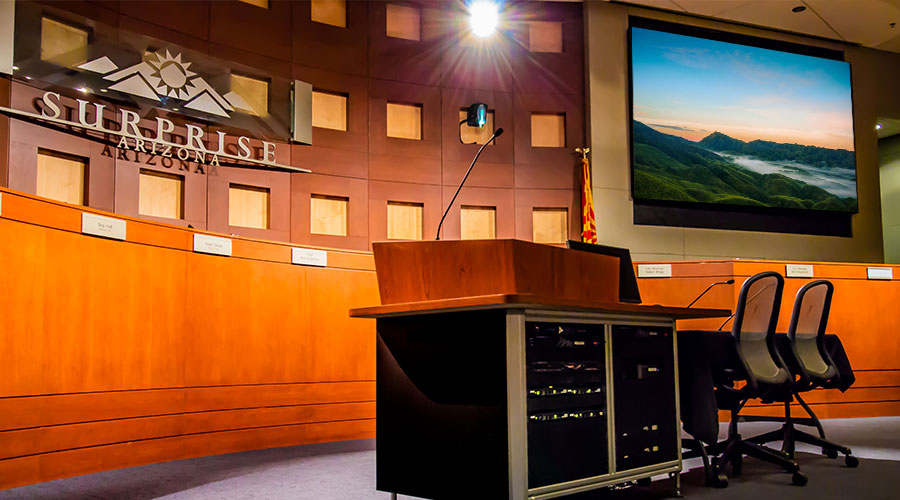
Why Local Governments Are Standardizing Audiovisual Systems and How to Keep Up
Picture a city council meeting where one room runs on crystal-clear microphones and flawless streaming, while the next relies on crackling speakers and outdated projectors. The inconsistency isn’t just inconvenient; it frustrates citizens, slows decision-making, and leaves taxpayers wondering why government technology can’t keep up. Across the country, municipalities are realizing that patchwork audiovisual systems for government facilities can no longer meet the demands of transparency, accessibility, and efficiency. That’s why more and more local governments are moving toward standardized AV solutions: one set of tools, one consistent experience, across every facility and department.
But here’s the challenge: while AV standardization offers cost savings and reliability, keeping pace with evolving public sector technology trends and what peer municipalities are doing can feel overwhelming. The question for city leaders, CIOs, IT directors, and facilities managers is no longer if standardization should happen; it’s how to make it sustainable.
Why AV Standardization Matters for Local Governments
Standardization is more than a technical upgrade; it is a shift in how local governments serve their citizens.
Public accessibility and transparency. Government AV systems support live streaming, ADA compliance, and user-friendly platforms that ensure every citizen can participate in meetings. Inconsistent technology undermines trust, while standardized solutions create a reliable public experience.
Budget efficiency. Instead of juggling multiple vendors and mismatched equipment, AV standardization for municipalities simplifies contracts, reduces maintenance costs, and stretches the life cycle of investments. This turns a recurring budget struggle into a long-term savings opportunity.
Consistency across facilities. From police network operations centers (NOCs) to council chambers, standardized AV means smoother training, faster deployment, and fewer technology hiccups when it matters most.
Together, these benefits form the foundation for stronger community engagement and smarter fiscal management.
Common AV Challenges Cities Face
If standardization delivers such clear advantages, why do so many cities struggle to achieve it?
Legacy systems. Many municipalities are dealing with decades-old equipment and a patchwork of upgrades that don’t communicate across departments. Government AV integration provides a path to replace these systems with interoperable solutions that eliminate fragmentation. What was once a source of frustration becomes an opportunity for long-term consistency.
Small budgets. Leaders are tasked with balancing technology upgrades with taxpayer accountability. While this often means tough decisions and delayed improvements, standardized platforms reduce long-term costs by simplifying maintenance and extending technology life cycles. What feels like a financial obstacle can become a predictable, budget-friendly strategy.
Department silos. Police, city council, and other agencies often procure AV independently, leading to inefficiencies and incompatibility. Standardization breaks down these silos by ensuring departments use the same systems, making training easier and collaboration seamless. Disconnected systems are transformed into unified operations.
While these frustrations are real, cities should know their peers are already moving forward. Municipalities are building real-time crime centers and updating council chambers with advanced AV, raising the bar for everyone else.
Government AV Case Studies in Action
To see what’s possible, look at municipalities already embracing AV standardization.
Mesa Police Department Real-Time Crime Center. With an integrated AV system, Mesa PD enhanced situational awareness and improved how teams share and act on critical information Read the case study.
City of Surprise Council Chambers. By standardizing AV, the city improved live streaming, accessibility, and user experience, ensuring smoother operations and greater community engagement Read the case study.
These examples demonstrate how thoughtful AV investments translate directly into better governance and stronger public trust.
How Local Governments Can Keep Up with AV Trends
So how can leaders ensure they’re not left behind?
Adopt a long-term strategy. Move away from piecemeal fixes toward planned upgrades that align with future municipal technology needs.
Focus on interoperability. Standardize on AV solutions for government facilities that work across all departments and can adapt as technology evolves.
Evaluate integrators carefully. Selecting the right partner is critical. See our guide on How to Vet Your AV Integrator.
Leverage managed services and monitoring. Reduce downtime, predict failures, and ensure consistency across facilities with proactive oversight.
Partner with experienced experts. Choose integrators with extensive government AV experience who understand the balance between innovation and budget responsibility.
Together, these steps create a roadmap for local governments to stay competitive while building systems that will serve their communities for years to come.
The Path Forward for Municipal AV Standardization
Local governments can’t afford to lag behind. Standardized AV solutions for municipalities aren’t just about technology; they’re about transparency, efficiency, and public trust. Cities that act now will not only save costs but also strengthen the connection between government and community.
Ready to build a future-proof AV strategy for your municipality? Partner with our team today.

